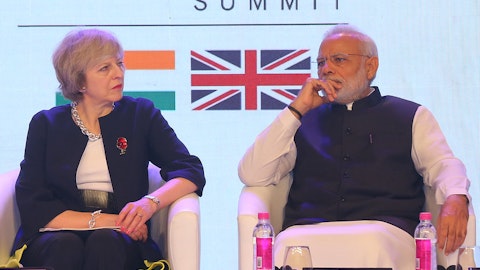Anindya Banerjee: Yes. So I think as far as the retail side is concerned, nothing specific to call out. I think it’s really spread across products. And if you look at the delta relative to the size of the portfolio, it is not a very high — not particularly meaningful. So as we have been saying, we would expect the net additions — both the gross and net additions on the retail side to gradually normalize upwards, both as the portfolio grows and seasons. And I’ll — on the corporate side, we did have 1 or 2 larger sort of upgrades this quarter. But in a way, the benefit in provisioning terms of that was kind of offset by the provisioning on the AIF investments. So taking it all together, if we look at kind of the credit costs, if we look at the provisioning for the quarter and eliminate maybe a very chunky corporate upgrade, eliminate the AIF provisioning and really try and look at an adjusted number, it would be still below kind of maybe 50 bps of loans and about 10 bps of the PPOP.
So that is the context in which we would look at the NPL formation and recoveries from our planning and risk appetite perspective.
Abhishek Murarka: Yes. And sort of extending that, does it mean that even in the next few quarters, we should continue to see credit cost in that range because you have enough PCR anyway, and that can come down a little bit. So credit costs can remain low for, let’s say, next 3 to 4 quarters. Is that a fair conclusion?
Anindya Banerjee: We don’t really give forward-looking thing, but I would say that, yes, I mean, I don’t see anything imminently that would cause it to spike up. There will be some gradual normalization upwards.
Abhishek Murarka: Got it. And my second question is just on cost of deposits. If you can share maybe your incremental cost of TDs or incremental cost of deposits, anything that you may have handy, that would be helpful?
Anindya Banerjee: So we not — we don’t publish those — that those numbers, Abhishek.
Operator: Next question is from the line of Rikin Shah from IIFL.
Rikin Shah: I just have one question on cost of deposits. If you could just qualitatively comment as to the repricing on the existing book of TD. Would you say that by 4Q, large — or most of it would already be repriced into the P&L? Or it could flow into 1Q as well?
Anindya Banerjee: There could be some flow into 1Q as well, but I think most of it should be done in before. There could be some flow into 1Q as well.
Rikin Shah: And this quarter, it increased 20 bps Q-o-Q. So in terms of the quantum, should it be kind of slowing down from the current run rate?
Anindya Banerjee: I would guess so.
Operator: Next question is from the line of Kunal Shah from Citi Group.
Kunal Shah: Sir, the question is on yield. When we look at it, in fact, the rise in some of the high-yielding portfolio, sequential growth has been strong, and we would have increased the rates even, say, post the tweaking of the risk weights by RBI, but still overall build on advances are down. So just want to understand on that bit. And this entire NBFC rundown, which has been there, is it like we tried to pass it on in terms of the rates and then there were repayments or we have been conservative post the risk weight stance from RBI?
Anindya Banerjee: So on the first question, I think part of the impact on the advances yield is because of the addition to the KCC NPL. So basically, what happens is that you kind of have to — you derecognize a year’s worth of interest income. So that does impact the yield on advances. In other parts, one, if you look at the share of the high-yielding portfolio, it is still not that high, and we have been — and we have seen decent growth in mortgages and auto and so on, and also on the corporate side, so — which continue to be pretty competitive. So I would say the yields have been broadly stable, and to some extent, any mix benefit that could have come has been offset by the nonaccrual on the KCC loans. On the — sorry, the second question was on the NBFC exposure.
I don’t — I mean, I guess, that we — then we keep looking at the various exposures from a risk-reward basis. I mean, we did not have any credit concern on these exposures, but they were finely priced exposures, and we have, therefore, borrowers — a couple of borrowers prepaid, and we were quite okay with that.
Kunal Shah: And how much rate pass was there in NBFC?
Anindya Banerjee: It would really depend on the client. I don’t think there is any role of some in that sense. I would — as you will see the book itself, I mean, even adjusting for this prepayment has not really grown much during the quarter. So there would not have been any very large lending that would have happened fresh.
Operator: Next question is from the line of Nitin Aggarwal from Motilal Oswal.
Nitin Aggarwal: Congrats on the results. So one question again around the yields and as to really, how do you look at the competitive intensity in unsecured products? And even in the mortgage, are you seeing that lenders cutting down on spreads because repo rates have been unchanged, but are the rates like seeing some moderation there? And — so basically — and going forward, how do you see the unsecured loan mix also moving for the bank? Because until now, it has been going very steady and some other private banks are indicating that they’ll continue to drive that up. So what will be our approach on the unsecured loan mix? So these 2 questions.





